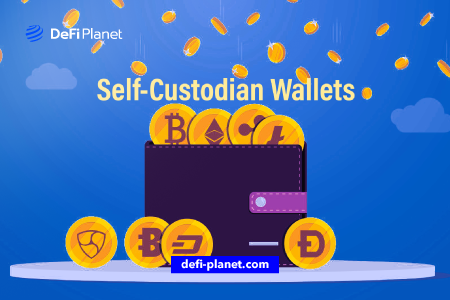Security is a top priority for many cryptocurrency users. Users are very concerned about protecting their assets against hacks, theft, or unauthorized access by third parties, whether they intend to hold crypto assets for a long time or actively participate in the DeFi or crypto markets. This is where cryptocurrency wallets come in, offering a safe place to store digital assets while also facilitating transactions.

Cryptocurrency wallets have existed since the inception of cryptocurrency, with the first Bitcoin-Qt wallet being released in 2009. It required users to save their private keys in a file named “wallet.dat” on their desktop, which, if lost, would result in the loss of all cryptocurrency holdings.
Since then, various wallets have been developed for different blockchains and purposes and can be classified into custodial and non-custodial/self-custody wallets.
For more information about the differences between these two categories, their types, and the important factors to consider when deciding which wallets to use for specific purposes, please take a look at our previous article on the topic.
Self-custody wallets have become a hot topic in the cryptocurrency world over the past few years. The increasing popularity of these wallets is due to the growing demand for secure and user-friendly cryptocurrency storage options.
They typically allow users to control their own private keys rather than storing them on a central server managed by a third party. This gives users complete control over their cryptocurrencies and eliminates the risk of a central authority mismanaging or losing their funds.
The recent hacks and losses suffered by cryptocurrency users have highlighted the importance of self-custody wallets, particularly in light of the collapse of centralized crypto platforms such as FTX.
Although the FTX collapse did shake investors’ faith in the system’s ability to keep their funds safe, not all hope is lost, as increased awareness of self-custody wallets demonstrates the crypto industry’s ability to create technological solutions that put customers in full control of their money without having to worry about third-party failures.
This article focuses on self-custody wallets, the recent increase in their use by crypto users, how they currently rank compared to non-custodial wallets, the events and trends that led to this surge, and the prospects for self-custody crypto wallets.
Why Self-Custody Wallets?
In an age where the internet reigns supreme and technology is constantly evolving, it is no surprise that the world of finance has also undergone a major shift towards decentralization. As digital assets have become increasingly valuable, so too has the importance of safeguarding them against theft and intrusion. This has led to a newfound appreciation for self-custody wallets and the power of individual control.
Once upon a time, central exchanges were seen as the securest way to store digital assets, but the recent high-profile hacks and security breaches that have rocked such establishments have shattered this illusion. The loss of millions of dollars worth of digital assets in these incidents has taught us a valuable lesson: that we are the guardians of our wealth and that the best way to keep it safe is to keep it in our own hands.
The rise of decentralized finance (DeFi) has only served to reinforce this trend. With DeFi platforms providing access to a wider range of financial services, from lending and borrowing to trading, there is a growing demand for self-custody wallets that enable users to participate in these platforms without having to rely on a centralized entity.

Similarly, decentralized exchanges (DEXs), which are decentralized marketplaces that allow users to trade cryptocurrencies directly from their wallets, have made self-custody wallets even more appealing.
The present user-friendly nature of self-custody wallets also makes them a very attractive option for users. In the past, they seemed rather technical to operate, but with the rise of mobile-friendly wallets, they have become more accessible and easily manageable for a wider range of crypto users.
Gone are the days when self-custody wallets were seen as complicated and technical. Thanks to the rise of mobile-friendly wallets, they have become more accessible and easily manageable for a wider range of crypto users. The phrase “not your keys, not your coins” has never rung truer, and understanding the benefits of self-custody has never been more critical.
Of course, the shift from centralized exchange wallets to self-custody wallets is not going to happen overnight. A recent survey by Trust Wallet showed that 43% of its users still store a considerable amount of their crypto holdings on centralized exchanges, but the remaining 57% store most of their assets on Trust Wallet, a self-custody wallet. This gradual transition to self-custody is the way of the future, and it is a trend that is sure to continue growing.
The growing adoption of self-custody wallets is a testament to the power of individual control and the importance of personal security and privacy in a world where digital assets are rapidly gaining value.
Types of Self-Custody Wallets

Self-custody wallets come in two main varieties: hardware and mobile.
Hardware wallets provide a secure way of keeping private keys protected, as they are usually connected to another device through Bluetooth or USB. Transactions are initiated and authenticated by signing with the private keys, and the signed transaction is then reflected back to the user, ensuring that private keys never leave the device.
Mobile wallets, on the other hand, are apps that can be downloaded from the IOS or Android store. They also allow users to directly purchase specific cryptocurrencies through integrated credit card purchases. These wallets come in three types: WEB3 Wallets, Smart contract wallets, and Regular “non-WEB3” wallets.
WEB3 Wallets provide regular functions, including a dApp browser, while smart contract wallets operate as programs on the blockchain. Regular “non-WEB3” wallets allow for the management of digital assets, such as BTC, LTC, ETH, and ERC20.
Mobile wallets offer a wide range of functions, including sending and receiving cryptocurrencies, trading on DEXs, and even fiat to crypto transactions (e.g., euro to BTC). They are highly preferred by most users as they provide a one-stop shop for all their crypto activities and allow for seamless management of assets across multiple blockchain networks.
Self-Custody Wallet Trends
The trend of self-custody wallets has seen a significant shift towards the integration of multi-signature technology.
Multi-signature technology requires multiple users to sign off on a transaction before it can be completed, providing an additional layer of security. This is especially useful for organizations and businesses looking to secure their cryptocurrency assets.
Technologies like multi-party computation (MPC) have also been developed to support the critical recovery and security of self-custody wallets, with the user maintaining control.
In recent times, there has been a growing demand for all-in-one wallet solutions that can meet the needs of cryptocurrency users. With the growing opportunities in DeFi, innovative products and services have been developed, but these are spread across different blockchain networks.
To fully utilize these opportunities, interoperability is essential. A multi-chain wallet that supports major blockchains and can store a wide range of crypto assets can enable users to easily swap their assets across different chains, connect to different decentralized applications (dApps), store and trade non-fungible tokens (NFTs) on multiple chains, stake different cryptocurrencies, and trade between different protocols or chains through a single solution.
Self-Custody in Web3
The Web3 infrastructure will almost certainly give birth to more technologies that will improve self-custody in the coming years. Self-custody solutions will vastly improve users’ privacy and give them even more control and ownership over their data.
With the growing importance of digital identity in the modern world, it is essential to take measures to minimize the risk of data breaches or hacks. Projects like Sovrin, Verida, and ShareRing are paving the way for users to gain control over their digital identities. These projects are working to ensure that users retain control over their data as the self-custody era of Web3 takes hold.
However, for this vision to become a reality, other key players in the industry must join forces and work together to overcome any challenges that may arise in achieving full control. Only then can the ownership and accessibility of digital assets be truly decentralized for all in the Web3 community.
In Conclusion,
- There is evidently a fundamental need for self-custody solutions, which would require secure, seamless, and scalable infrastructure. The self-custody wallet industry has continued to grow and birth innovative trends to meet this need.
- The rise of DEXs, user-friendly wallets like hardware and mobile wallets, and even the multi-signature technology are merely precursors of how much more growth the industry will enjoy as the decentralized and larger Web3 space evolves.
- The prospects for self-custodial wallets in the crypto industry are very promising, as exciting trends like the non-fungible tokens (NFTs) and other emerging digital assets will further strengthen the adoption of secure and user-friendly self-custodial wallets that allow users to manage their digital assets and participate in the constantly evolving world of DeFi.
If you would like to read more articles like this, visit DeFi Planet and follow us on Twitter, LinkedIn, Facebook, and Instagram.





















